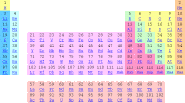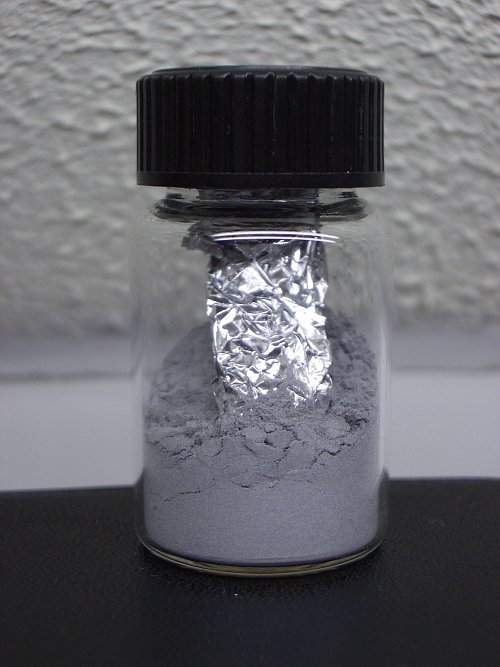


Aluminium
 Aluminium is a silvery white metal
in the bulk state and it looks grey, when finely powdered. The metal is very
electropositive. In spite of that, in the bulk state it is remarkably inert and can be used in
many constructions, tools and equipment. The inertness is caused by formation of
a very thin, but impermeable oxide layer, which protects the underlying reactive
metal from further oxidation. Powdered aluminium is much more reactive.
Aluminium is a silvery white metal
in the bulk state and it looks grey, when finely powdered. The metal is very
electropositive. In spite of that, in the bulk state it is remarkably inert and can be used in
many constructions, tools and equipment. The inertness is caused by formation of
a very thin, but impermeable oxide layer, which protects the underlying reactive
metal from further oxidation. Powdered aluminium is much more reactive.
If the protective oxide layer can be removed and buildup of a new protective layer can be prevented, then one really sees how reactive the metal is. This is nicely demonstrated in an experiment with aluminium metal, table salt and copper sulfate, where by means of complex formation the protective layer is destroyed and no new protective layer is built up anymore.
Aluminium metal certainly adds something to the home lab. The metal can be used in a large number of experiments. It can be used as a convenient source of hydrogen with some dilute hydrochloric acid. It can be used for interesting dry chemical experiments, when in powdered form.
Aluminium can be obtained as household foil in any supermarket. Hardware stores sell aluminium strips of all lengths and sizes for construction purposes. With an iron-saw, coarse powder can be made by sawing the strips of aluminium. Finer powders sometimes can be purchased on eBay and at chemical supply houses. Medium fine powder also is available in art and paint stores. These powders usually consist of small flakes/'leaves', which are covered by some waxy or greasy substance. By rinsing them a few times with acetone and evaporating to dryness, a nice dry powder can be obtained, which is perfectly suitable for the type of experiments, discussed on this site.
![]() Be warned not to
use the ultra fine powders (e.g. german dark, indian black), used in
pyrotechnics, when you have no experience with them. The ultra fine powders can
be used for making really bright flash powders and salutes, but without proper
equipment, guidance and experience this is really dangerous, both for yourself
and other people. Mixtures of oxidizers with ultra fine aluminium powder can be
very sensitive and might ignite apparently without reason (e.g. a small spark,
due to static electricity might ignite such a mixture). The very fine powders
give mixtures, which 'burn' extremely violently and very hot! For experiments,
involving aqueous chemistry, the ultra fine pyro-powders hardly are suitable.
These contain quite some carbon, which makes them unreactive in an aqueous
environment.
Be warned not to
use the ultra fine powders (e.g. german dark, indian black), used in
pyrotechnics, when you have no experience with them. The ultra fine powders can
be used for making really bright flash powders and salutes, but without proper
equipment, guidance and experience this is really dangerous, both for yourself
and other people. Mixtures of oxidizers with ultra fine aluminium powder can be
very sensitive and might ignite apparently without reason (e.g. a small spark,
due to static electricity might ignite such a mixture). The very fine powders
give mixtures, which 'burn' extremely violently and very hot! For experiments,
involving aqueous chemistry, the ultra fine pyro-powders hardly are suitable.
These contain quite some carbon, which makes them unreactive in an aqueous
environment.
![]() When the material
from art and paint stores is degreased and dried, be careful not to inhale fine
particles of aluminium. The dry metal pieces have a very large surface/weight
ratio and are very easily blown into the air. Having these little metal pieces
in your lungs is not fun at all!! If in doubt, wear a dust mask!
When the material
from art and paint stores is degreased and dried, be careful not to inhale fine
particles of aluminium. The dry metal pieces have a very large surface/weight
ratio and are very easily blown into the air. Having these little metal pieces
in your lungs is not fun at all!! If in doubt, wear a dust mask!
![]()
In its compounds, aluminium almost always has the +3 oxidation state. It forms partly ionic, partly covalent compounds.
![]() For the general public, aluminium sulfate, Al2(SO4)3·18H2O,
and potassium aluminium sulfate, KAl(SO4)2·12H2O,
also known as alum, are available. Both of these are white crystalline solids.
These salts can be used as a source of aluminium ion for aqueous experiments.
Alum can be used for nice crystallization experiments, especially, when it is
combined with a small amount of chrome alum.
For the general public, aluminium sulfate, Al2(SO4)3·18H2O,
and potassium aluminium sulfate, KAl(SO4)2·12H2O,
also known as alum, are available. Both of these are white crystalline solids.
These salts can be used as a source of aluminium ion for aqueous experiments.
Alum can be used for nice crystallization experiments, especially, when it is
combined with a small amount of chrome alum.
![]() Aluminium oxide, Al2O3, is available from pottery or
ceramics stores as a white powder, but this is not interesting for the home
chemist. Usually this oxide is ignited. Heating of metal oxides frequently makes
them very inert. This also is the case for aluminium oxide. Even strong alkalies
or concentrated acids are not capable of dissolving this oxide at an acceptable
rate.
Aluminium oxide, Al2O3, is available from pottery or
ceramics stores as a white powder, but this is not interesting for the home
chemist. Usually this oxide is ignited. Heating of metal oxides frequently makes
them very inert. This also is the case for aluminium oxide. Even strong alkalies
or concentrated acids are not capable of dissolving this oxide at an acceptable
rate.
![]() Usually, aluminium compounds are white, because of the fact that Al3+
ion is colorless. A remarkable exception to this is the not well understood
mineral ultramarine, also known as lapis lazuli. This is a complex
sulfur-containing sodium aluminium silicate with approximate formula Na8..10Al6Si6O24S2..4.
It is bright blue. This material is quite inert, except in the presence of
acids. It looses its bright blue color and produces hydrogen sulfide in the
presence of acid.
Usually, aluminium compounds are white, because of the fact that Al3+
ion is colorless. A remarkable exception to this is the not well understood
mineral ultramarine, also known as lapis lazuli. This is a complex
sulfur-containing sodium aluminium silicate with approximate formula Na8..10Al6Si6O24S2..4.
It is bright blue. This material is quite inert, except in the presence of
acids. It looses its bright blue color and produces hydrogen sulfide in the
presence of acid.
Aluminium ion is fairly unreactive. It has no interesting redox chemistry in water. Aluminium can form complexes with many compounds and it also can give interesting precipitates with many anions.